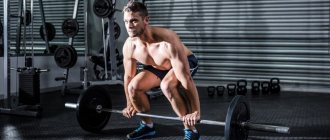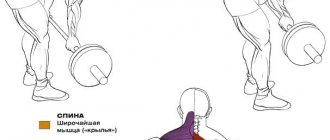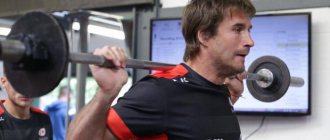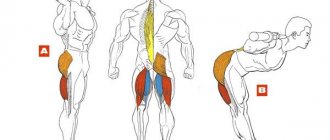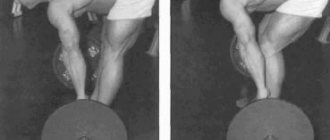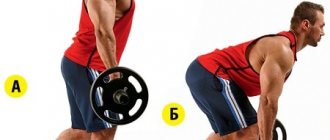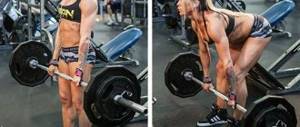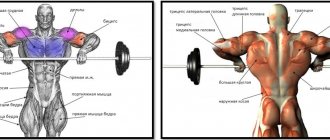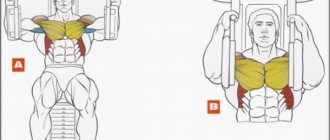The deadlift in bodybuilding is deservedly considered one of the best exercises that promotes the rapid gain of muscle mass and the development of physical strength. The fact has long been tested in practice that it is in principle impossible for a bodybuilder to achieve impressive amounts of muscle mass without deadlifting.
The main feature of this exercise is that when performing it, almost all large muscles in the spine, hips and buttocks are involved. In addition, deadlift is very close to human physiology , because each of us periodically has to lift various things.
If the above hasn't convinced you yet, try this exercise yourself. Definitely, no exercise machine will give you such a feeling of pumping up all your muscles!
Like any strength exercise, the deadlift has its own correct technique, and we’ll talk about it.
Deadlift "Tools"
Let's start with the fact that this exercise works in three directions:
- competitive traction;
- strengthening the muscles in the back;
- formation of the athlete’s frame.
Based on the directions, the main goals of the bodybuilder are identified:
- Gradual increase in weight on the barbell.
- Strengthening the rectifiers in the spine.
- Increases overall strength of the back muscles.
To achieve these goals, 4 types of deadlifts :
- in the style of " Sumo "
- in " Classical " style,
- «Deadlift»,
- traction “ From the plinths ” (plinths are stands for the barbell, bringing it to the knee level position).
The list of “hardware” for deadlift includes things familiar to every weightlifter: an Olympic bar (20 kg), locks and plates, plinths and straps, a weightlifting belt and chains, chalk or magnesium.
Load by muscle group
The load is indicated on a 10-point scale (the total load is summed up)
| Small of the back | 8 (high) |
| Buttocks | 8(high) |
| Front thigh | 8 (high) |
| Posterior thigh | 5 (average) |
| Upper back | 4 (average) |
| Inner thigh | 3 (average) |
| Forearms | 3 (average) |
| Outer thigh | 2 (weak) |
| Total load/exercise type | 41 (high) / basic global |
| Load on the spine | 8 (high) |
Execution technique
Initial position:
- Take your starting position, standing on a slight elevation: feet approximately shoulder-width apart, toes slightly turned outward.
- In this case, the barbell is located on the floor, and its bar is located at a distance of approximately 2-4 cm from the shin.
- Squat down until your thighs are parallel to the floor, lower your pelvis, and raise your head.
- Take the barbell with a pronated (overhand) grip or an overhand grip, spread your shoulder blades, bend your back and lock it in this position.
Movement:
- Tighten your abdominal muscles as much as possible, inhale and hold your breath. Using the force of your legs, lift the barbell off the platform and begin lifting the apparatus vertically upward along your shin.
- When the bar reaches knee level, continue lifting and begin to straighten your back.
- Straighten up completely, squeeze your shoulder blades and buttocks together a little - lock the barbell in the final position and exhale.
- Without lifting the barbell from your feet, also lower it smoothly and under control onto the platform.
Attention! Recommendations!
Description of the exercise
It's a pull from the pit. It is performed in the same way as the classic version, but the legs are placed on a stand. Thus, the barbell must be pulled and lowered to a lower position. The amplitude increases - the efficiency increases. The height of the stand is 5 – 10 cm. Discs, boards and anything that you can confidently stand on are suitable.
The exercises are difficult to perform and are only suitable for experienced athletes. But it is extremely effective for the buttocks. I would put it in first place in terms of effectiveness for the butt among all pull-downs. But there is one caveat. You need to bend your legs and lower your pelvis quite low (much like in the video). And then you will feel your butt right to the bones.
Key tips
1. You can start with small stands of 3–5 cm. For example, place your feet on discs from a barbell.
Your back should be straight throughout the entire movement. If you are unable to get low and keep your back straight, then this exercise is not for you. 2. Alternatively, if there are no stands, you can use a wide (snatch) grip. The grip is 2 times wider than the shoulders. With this option, you will have to go lower to reach the floor with the disks. That is, the effect of a wide grip will be the same as that of stands.
3. If the stand is too high, simply do not lower the bar all the way. Although, it is advisable to choose a stand of such a height that you just need to lower the barbell to the floor.
4. By the way (applies mainly to girls), if you do deadlifts with small-diameter discs, then you don’t have to stand on a stand, but simply lower the barbell all the way to the floor. The effect is the same. This refers to discs whose diameter is smaller than the standard diameter of 15, 20 and 25 kg discs.
An auxiliary exercise for deadlifting is block rowing.
When performing deadlifts with a large weight, the hand may not withstand such a large load and become loose. To develop the holding power of the hands, do an auxiliary exercise - pull-ups from the plinths with retention (Fig. 2.29). It is advisable to perform holds with a direct grip, so the grip strength will be worked out most optimally.
Fig.2.29. Deadlift from plates with hold.
Skirting boards are wooden cubes, usually covered with rubber. The size of the plinths is approximately 40cm by 40cm by 40cm.
After you've done a "heavy" deadlift, you place the barbell on the bars and increase the weight of the barbell. This is usually 10-50 kg more than when performing deadlifts. You approach the barbell, lift it and try to hold it for as long as possible, for example, 20-30 seconds. Then lower the barbell back onto the plinths. This is one approach. You need to do 2-3 such approaches.
This auxiliary exercise is very important when moving on to serious weights. I think that, over time, you won’t be able to do without it.
However, the hands can be strengthened in other ways - by hanging on a bar with a load suspended from the belt, or by holding rubber pancakes with your fingers.
The main thing is that the load is static. Dynamic load will only relax your hands and make them weaker.
And on the powerlifters forum (www.powerlifting.ru) they told about such a case and a method for strengthening the grip:
“I’ll tell you an interesting story. Once when I was a child, I went with a friend to buy something for the house. At the market we stopped at some kind of trading tent (they sold all sorts of rubbish for the house - hammers, saws, etc.).
It so happened that a small squabble broke out between my friend and the seller. An acquaintance of mine took his pliers from the counter and, squeezing the handles with one hand, broke them, then took others, again with the same success.
Well, he said, like, “You’re an asshole and your instrument is an asshole.” The seller was very happy that it all ended this way and not any other way.
And now I’ll tell you how he strengthened his grip...
Firstly, I did it only in statics. First, he took a small block of soft wood, crushed it, and crushed it for about six months. Then he took harder rocks and crushed them again. And in the end he took the brick and actually crushed it by squeezing it with his fingers. All this is real and I saw it with my own eyes. I even saw him pounding a beer bottle in one hand without straining.”
So, if you follow these recommendations, you will not have problems with your grip.
I want to emphasize that all auxiliary exercises (auxiliary exercises) are added to the basic exercises only if really necessary.
Those. if a person is healthy, then he should start with basic exercises, then for several months (or years) do only these exercises, and then, along the way, see what can be corrected and where, and what auxiliary exercises can be introduced into the training schedule.
It’s another matter if a person initially has a problem, for example, severe scoliosis. In this case, of course, you must first solve the problem of scoliosis, and only then increase the weight in basic exercises.
That is, I emphasize once again, all the utility room is strictly necessary. The choice of auxiliary exercises (auxiliary exercises) is determined not by the desire or reluctance of the athlete, but by urgent need.
The main mistake most athletes make is that they DO NOT do this.
Most athletes perform assistance without any need, which slows down their progress.
I will try to explain why it is important to reduce the number of exercises to a minimum and limit ourselves mainly to basic exercises, and for this I propose to look at this problem from a physiological point of view.
I’ll start with an important quote from the Popular Medical Encyclopedia:
“The capacity of the circulatory system (arteries, veins, capillaries) is significantly greater than the total volume of blood in the body.”
You may be surprised, but, contrary to popular belief, blood does not fill our circulatory system to the brim, but with more or less constancy is located only in some part of the body, leaving a significant proportion of the vascular system EMPTY .
This fact is remarkable, significant and new not only for a person far from medicine, but, as a rule, also for some professional doctors. Which, of course, “passed” it during their studies, but were forgotten as unnecessary.
And, nevertheless, this fact is indisputable, and the story of the mummification of Mao Tse-tung can serve as a clear illustration of it.
When the Chinese leader died, his comrades decided to mummify the body. This kind of tradition was absent in Chinese funeral culture, and the authorities did not dare to turn to Soviet revisionists for help, and the doctors were given the order to make do with their own strength and experience.
As the doctor who participated in this adventure said, the Chinese took the path of least resistance and simply pumped blood out of the body and began pumping formalin in its place, logically assuming that the volume of the circulatory system would itself limit the amount of preservative pumped in.
Imagine the horror of the inexperienced mummifiers when, before their eyes, Mao’s corpse began to inflate, taking the shape of a ball.
Having abandoned all procedures, they agreed to hide what happened, leaving time to solve the problem. This conclusion turned out to be wise; for two weeks the leader’s corpse sweated formaldehyde, and finally, the body returned to its original size and appearance.
In this regard, it should be said that happiness was on the side of Chinese doctors to a much greater extent than they expected. If they had persisted in their desire to fill Mao’s circulatory system with formaldehyde, then it would be difficult to vouch for their mental health.
The thing is. that the length of the human circulatory system (primarily the total length of the capillaries) is 100,000 kilometers (!). By stretching all the capillaries in one line, you can wrap the globe around the equator two and a half times.
Nobel laureate in medicine Dr. Alexis Carrel (USA) calculated that 200,000 liters of blood would be required to completely fill the circulatory system, i.e. 2 liters of blood per kilometer, while our body has only 5-7 liters!
Thus, if the Chinese mummifiers persisted, they would hardly have been able to complete their experiment, because there would not have been 200 thousand in all of Beijing. liters of formaldehyde (more than three railway tanks), but even if it had accumulated, so much the worse for the experimenters - the body of the leader beloved by the Chinese people would have taken on such a form that the death penalty would have seemed to doctors not the greatest punishment for them.
Several instructive conclusions can be drawn from this unusual story.
First. If our vascular system (including all capillaries) were filled to the brim, then, due to the gigantic potential capacity of the capillaries, we would look like balls with a volume and weight of more than three tanks.
The capillaries are very thin - 30 times thinner than a hair. The length of the capillary does not exceed 0.5 mm. But there are very, very many capillaries.
For example, around the superior mesenteric artery alone there are 72 million capillaries. The cross-sectional area of each capillary is approximately 0.00008 sq. mm. If all these capillaries were filled, then the total cross-sectional area of all the capillaries near this artery would be 57.6 sq.cm. This is many times larger than the diameter of the most superior mesenteric artery (0.69 sq.cm).
Second. Judging by the sweat that Mao's corpse emitted, even a slight excess of fluid is unacceptable for the physiology of a dead organism, not to mention a living organism.
Third. There is a reason for the incompleteness of the system: if, as we know, there are circumstances that require a special flow of blood to the organs, then it also needs to flow somewhere, it needs voids for possible retreat.
The human body is a desert, but a desert that has no earthly equivalent in dehydration.
A tiny drop of blood hovers over kilometers of human interior desert , carried from end to end with the sole purpose of preventing the desert from becoming completely barren.
And for several decades she has succeeded in this - that’s the trick.
At the same time, there is nothing particularly good in the desert of the vascular system. Obviously, without nutrition and oxygen brought by blood to the organs, they quickly age and die.
Blood constantly circulates only in a triangle: lungs - heart - liver. If we judge by the size of the vessels, then we can imagine the geography of places visited by blood with greater or less constancy: “The caliber of the arteries and veins of organs is directly dependent on the functional purpose of the organs. Organs such as the kidney and endocrine glands, despite their relatively small size, are supplied by large arteries, as they have an intense function. The same applies to some muscle groups.”
Intensive blood flow to other organs can be caused artificially: after having lunch, you can drive the blood to the stomach, cooling the surface of the body, or vice versa, heating in a bath can increase blood flow in the skin, etc.
However, not all organs are amenable to such direct provocation and, judging by the size of the vessels, not all of them are constantly and automatically supplied with blood.
Reasoning purely logically, and knowing that the volume of blood is always significantly less than the volume of the circulatory system, it would be natural to assume that the least amount of blood enters the organs and departments located at the greatest distance from the heart, on the periphery.
Simply put, what suffers first from a lack of blood is what is supplied by the capillaries.
Distance from the heart is not the only problem with capillary blood supply.
What’s even worse is that between the arteries and capillaries there are arterioles , which are, in the words of I.M. Sechenov, “faucets of the circulatory system”, free to let or not let blood into the capillaries. That is, not only is it difficult for blood to flow by gravity into the capillaries due to their distance from the pumping station, but it is generally difficult to get there without special permission, an order given by the body.
The capillaries of the brain do not have “tap” arterioles, but they have their own neurohumoral system for regulating blood flow. By the way, this is why it is impossible to achieve gravity flow, and with it solving the problems of blood supply to the brain, by simply standing on your head in yoga.
It's a pity. The capillary system of the brain is extremely branched. Moreover, the more important the brain area, the stronger the branching. For example, in 1 cubic. mm. The white matter of the brain contains only 220 capillaries, while one cubic mm. gray - 1000. The capillary networks of the hypothalamus and pituitary gland are extremely dense. The part of the pituitary gland that is responsible for the production of the very important hormone of joy - endorphin - is not supplied with nerve endings (they stop just at the border of this area of the pituitary gland), but at the same time, it is from this border that the capillary network of the pituitary gland begins to rapidly branch (i.e. stimulate the production endorphin via the neural network is impossible; this can only be done through the capillary blood supply system).
Summarizing what has been said, it remains to state that the issue of normal nutrition of the most important parts of the brain is a capillary issue, i.e. “according to” the human blood supply is a secondary issue and depends on the whims of the organism giving the special order.
Well, now let's summarize some results.
So:
The volume of blood is always much less than the volume of the circulatory system, so a significant part of it is constantly empty, forcing various organs of the body and their departments to constantly starve and age early.
Throughout a person’s life, there is an ongoing competitive struggle for blood inside his body. Those parts of the body that are fed by capillaries, including the brain, suffer more than others in this struggle.
Now let's return to the issue of training and remember that training is accompanied by increased blood flow in the muscle area.
Data from observations of muscles at rest and in a state of work have shown that the number of capillaries through which blood flows depends on the condition of the muscle. In a resting muscle, only a small part of the capillaries is open ( approximately 2 to 10% ), and only blood flows through them. When the muscle begins to work, the entire dense capillary network opens.
The main vital resource of blood is concentrated near the working muscles and leaves other organs without its service.
Let's remember what a tired person experiences after a workout: no thoughts, no emotions, no desire to speak or move, he can breathe heavily, his gaze is drowsy and motionless.
And all because the blood has gone to the muscles, and the look is drowsy, motionless - for the same reason - the blood has even left the eye muscles.
Thoughts and emotions disappear - the mind (cerebral cortex) and pituitary gland also remain drained of blood and therefore slow down their work.
Let me remind you once again about this amazing fact of our physiology: the length of the circulatory system is 100,000 kilometers; for its complete and simultaneous irrigation, 200,000 liters of blood are required, while we have only 5 liters of it, i.e. Roughly speaking, the human circulatory system is filled to 1/40,000 of its potential volume.
Therefore, the life history of our body is a history of frenzied competitive struggle between different organs for this meager resource. From this expressive fact it is easy to draw a banal and eternally original conclusion: those who do not do two things at the same time live longer and more fruitfully . If you have a meager resource of something (in this case, blood), then it makes more sense to concentrate it primarily in one important area.
That is why it is important to distribute the load in such a way as to use this most valuable resource as efficiently as possible.
Always focus all your resources on the most important thing!
Only hard basic training is the basic law of proper training.
By performing isolated exercises (working triceps, biceps, lats in isolation, etc.), we deprive large muscle groups of blood flow and thereby prevent them from growing. By performing isolated exercises, we slow down our growth in basic exercises. But it is the basic exercises that provide the main increase in strength and muscle mass - so why should we slow down our own growth? Why take away from the main muscles what they so lack for recovery and growth - oxygen and energy (i.e. blood)?
Therefore, be very careful about any auxiliary exercises - meticulously choose only those that are vital for solving a specific problem. Ruthlessly exclude all other auxiliary and isolated exercises from your training schedule, otherwise, by giving energy and nutrition (i.e. blood) to them, you deprive this most valuable resource of those muscles that are responsible for strength and body weight.
Only by focusing on basic exercises can you make the most of your resource and quickly achieve outstanding results, both in increasing muscle strength and in increasing muscle mass.


